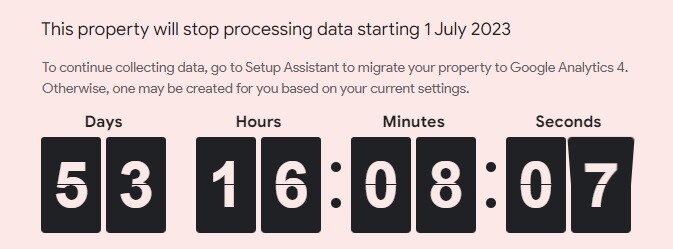With Universal Analytics now less than 2 months away from sunsetting, upgrading to Google Analytics 4 should now be a priority for your online business.
Starting in July 2023 (less than 60 days away), Google Analytics in its current form, Universal Analytics (UA), will stop recording data completely. To continue recording visitors and tracking events on your website, you will need to set up Google Analytics 4 or a different analytics tool. GA4 is not just an update to the old Google Analytics, but a brand new way of doing analytics that works better for today’s users who visit on different devices and platforms.
If you’re still using UA, you might be wondering why you should bother switching to GA4 and what are the benefits of doing so. In this blog post, we’ll break down the main differences between GA4 and UA and give you 5 reasons why you should get Google Analytics 4 set up as soon as possible.
1. GA4 tracks events, not sessions
One of the biggest differences between UA and GA4 is how they track data. UA uses a data model based on sessions and pageviews, but GA4 measures data based on events. What does that mean?
UA collects and measures different user interactions with your website or app within a certain time frame (by default, 30 minutes) as sessions or ‘hits’. Mainly, UA tracks only page views across your properties. If you want to track other things, like clicks, downloads, or purchases via ecommerce, you need to do some additional setup with event tracking and Google Tag Manager.
GA4 tracks everything that happens on your website or app as ‘events’. This new data model gives you a complete picture of how users engage with your business on and off the web, without any hassle.
There are 4 types of events in GA4:
- Automatically collected events: These are basic events that GA4 tracks automatically without any extra setup, like page views, scrolls, link clicks, etc.
- Enhanced measurement events: These are events that GA4 tracks automatically if some additional settings are enabled and configured, like file downloads, outbound clicks, site search, etc.
- Recommended events: These are events that GA4 suggests for specific interactions on your website, like ecommerce & app actions. They have predefined names and parameters that help you measure common and similar user actions and behaviours.
- Custom events: These are events that you can create and track according to your own online business needs and goals. You can use any name and parameter for these events, though we do recommend following a naming convention to keep things simple and tidy.
By using an event-based data model, GA4 lets you track more detailed and meaningful user interactions across your properties and platforms. You can also easily create custom reports and analysis based on these events without relying on complex code or third-party tools.
2. GA4 has a simpler data setup than UA
Another major difference between UA and GA4 is how they organise the data setup for your properties. UA uses a hierarchical structure of accounts, properties, and views to collect and display your data. Each account can have multiple properties (like websites or apps), and each property can have multiple views (like filters or segments) to analyse your data.
GA4 simplifies this structure by using only accounts and properties. Each account can have multiple properties, but each property can only have one view. Instead of using views to filter or segment your data, GA4 uses data streams to collect data from different sources (like websites or apps) within the same property. You can then use analysis modules (like reports, explorations, funnels, etc.) to analyse your data across different data streams.
By using a simpler data setup, GA4 makes it easier for you to manage and compare your data across different platforms and devices. You can also use BigQuery to export and query your raw data for advanced analysis and integration with other tools.
Free Digital Tips Direct to your Inbox!
Be among the first to receive tips, advice and news on all things digital performance related. From new features in Google Analytics, Data Studio and other tools, to interesting articles, videos and more! Completely Free! (Unsubscribe any time you like!)
3. GA4 tracks users differently than UA
Another important difference between UA and GA4 is how they track users for your properties. UA uses two identifiers to track users: Client ID and User ID. Client ID is a random number that is assigned to each device or browser that visits your website or app. User ID is an optional feature that lets you assign a unique identifier to each logged-in user across devices or browsers. Because of this, UA does often require third-party cookies to operate, by storing information into your browser.
GA4 uses only one identifier to track users: Google Signals. This allows Google Analytics 4 to use three metrics, Total Users, Active Users, and New Users and track users across different devices and platforms. Google Analytics 4 can also provide additional information about users by using machine learning to help fill in gaps about your audience that may not be trackable otherwise (such as a user rejecting cookies on a website).
4. GA4 has more advanced features than UA
Google Analytics 4 is not just a different version of UA, but also a more in-depth and powerful one. GA4 has many new features that are not available or limited in UA. Here are some of them to consider :
- Smarter AI-powered insights and predictions: GA4 uses machine learning to automatically show you insights and trends based on the data that your website collects. For example, GA4 can alert you when there are big changes in your data, like spikes or drops in revenue, conversions, or retention.
- Deeper integration with Google Ads: Google Analytics 4 has a tighter integration with Google Ads that lets you optimise your campaigns and reach your target audiences more effectively across platforms. GA4 can automatically create audiences based on your analytics data and sync them with Google Ads, allowing you to use GA4 to measure the impact of your Google Ads campaigns across different platforms and devices.
- Customer-centric measurement and customer life cycle reports: GA4 focuses on measuring the customer journey across platforms and devices, rather than just sessions or page views. GA4 provides you with new reports that help you understand how users engage with your business throughout their life cycle, from acquisition to retention to monetization. You can also create custom reports and analysis based on user properties, events, and parameters that matter to you.
5. UA will stop working by July 2023
The final and most urgent reason why you should switch to GA4 is that UA will stop working by July 1, 2023. This means that after this date, UA will no longer collect new data from your website. You will still be able to see your UA reports for a while after this date, but they will not show any new data or changes.

If you want to keep using Google Analytics and benefit from its features and capabilities, you will need to move to GA4 before this deadline. The sooner you do it, the better, as it will give you more time to get used to GA4 and collect enough historical data for comparison and analysis.
How to move to GA4 from UA
If you are ready to move to GA4 from UA, here are the steps you need to follow:
- Set up a new GA4 property next to your existing UA property. This will let you collect data in both properties at the same time and compare them.
- Install the global site tag (gtag.js) on your website or install GA4 by using Google Tag Manager (which we would recommend).
- Configure your GA4 property settings according to your business needs and objectives. You can use the enhanced measurement feature to automatically track common events on your website. You can also set up custom events, parameters, and user properties to track specific user actions as they browse your website.
- Explore the new reports and analysis modules in GA4 and learn how they differ from UA. You’ll want to try and get familiar with Google Analytics 4 before UA stops recording data!
- Export your historical data from UA if you want to keep it for future reference or analysis. You can use tools like Google Looker Studio or BigQuery to export and visualise your UA data.
Conclusion
Google Analytics 4 offers many benefits over Universal Analytics. From using an event-based data model that lets you track more detailed and meaningful user interactions across platforms and devices, to just having more advanced features that help you gain deeper insights into your data, GA4 is arriving soon to replace Universal Analytics. Most importantly, UA will stop working by July 2023, so you need to switch to GA4 as soon as possible.
Don’t wait any longer and make the move to Google Analytics 4 now. You’ll be glad you did and if you need any help with setting up or using GA4, feel free to contact us today. We’re here to help you get the most out of analytics for your online business.





